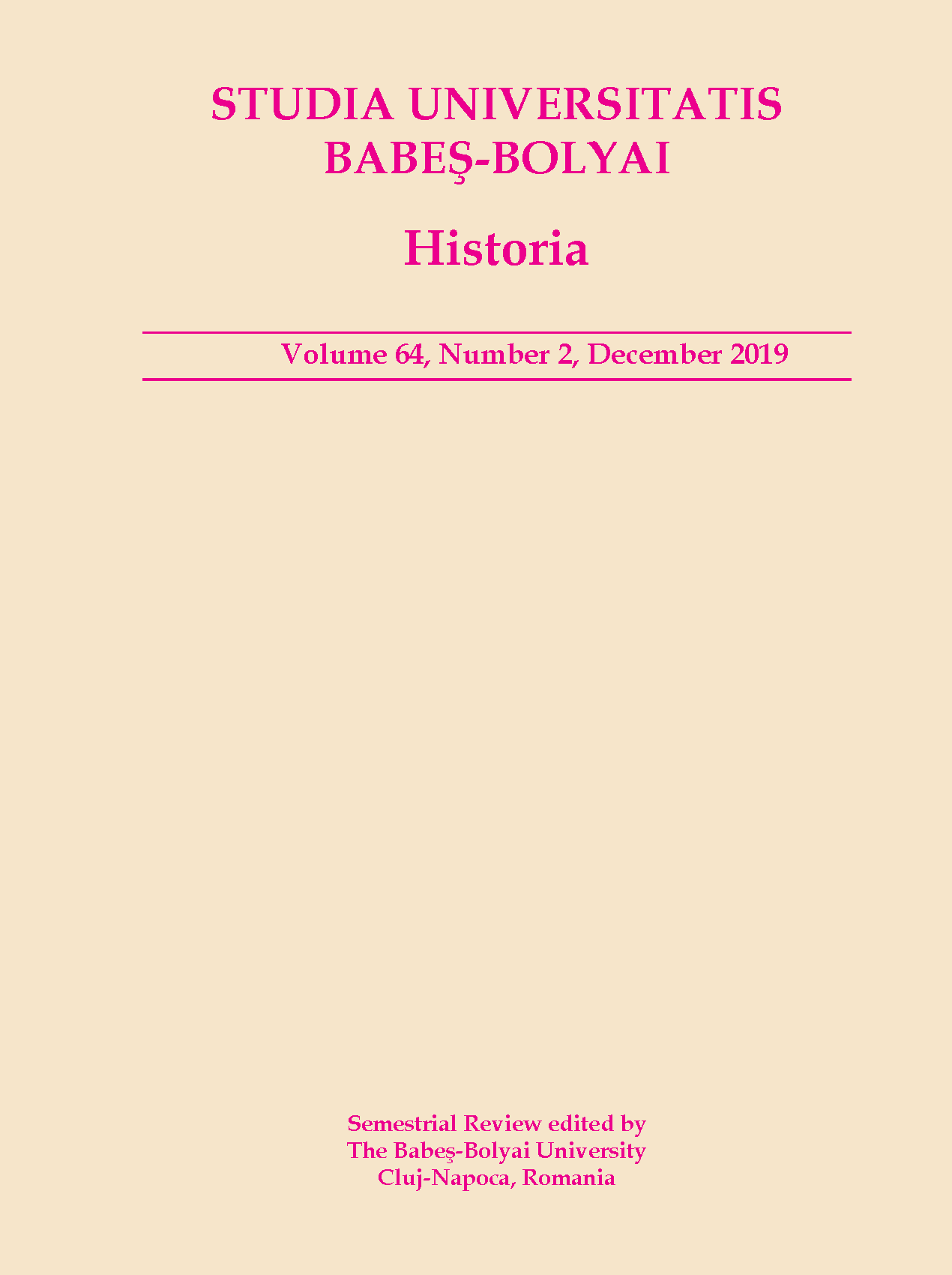The Idealized Rome in the Romanian Historical Imaginary before 1918
DOI:
https://doi.org/10.24193/subbhist.2019.2.02Keywords:
heritage of the Classical world, founding myths, national identity, ideal ancestor, modernization.Abstract
By the time when Transylvania became part of Romania in 1918, the idealized image of ancient Rome became a defining element of the Romanian historical imaginary. An important factor in this evolution was the gradual emergence of the modern national identity constructs in the context of several internal and external social-political and cultural transformations which shaped the ways in which various social groups integrated the past into their collective memory. As a consequence, the idealized ancient Rome was gradually transformed from an intellectual ideal to an ideal ancestor to a driving force in the nation’s quest for modernization.
Rezumat: Roma ideală în imaginarul istoric românesc înainte de 1918. La data la care Transilvania a ajuns să facă parte din România, în 1918, imaginea idealizată a Romei antice a devenit un element definitoriu al imaginarului istoric românesc. Un factor important al acestei evoluţii a constat în emergenţa graduală a constructelor identităţii naţionale moderne, în contextul transformărilor social-politice şi culturale interne şi externe, care au conturat modalităţile în care diferite grupuri sociale au integrat trecutul în memoria lor colectivă. Ca urmare, imaginea Romei antice a fost transformată treptat, dintr-un ideal intelectual al strămoşului exemplar într-o forţă conducătoare a procesului de modernizare naţională.
Cuvinte-cheie: moştenirea antichităţii clasice, mituri fondatoare, identitate naţională, strămoş exemplar, modernizare.
References
Almási 2010: G. Almási, Constructing the Wallach “other” in the late Renaissance. In: B. Trencsényi, M. Zászkaliczky (ed.), Whose Love of Which Country? Composite States, National Histories and Patriotic Discourses in Early Modern East Central Europe. Brill, Leiden – Boston 2010, 91-129.
Armbruster 1993: A. Armbruster, Romanitatea românilor. Istoria unei idei. Editura Enciclopedică, Bucureşti 1993.
Babeş 2005: M. Babeş, 170 de ani de arheologie românească. Studii şi Cercetări de Istorie Veche şi Arheologie 54-56, 2005, 9-20.
Bodor 1995: A. Bodor, Erdély ókori történetének kutatása a XIX. század közepéig. Erdélyi Múzeum 3-4, 1995, 56-81.
Bradley 2010: M. Bradley, Tacitus’ Agricola and the conquest of Britain. Representations of empire in Victorian and Edwardian England. In: M. Bradley (ed.), Classics and imperialism in the British Empire. Oxford University Press, Oxford, 2010, 124-157.
Demoule 1999: J. P. Demoule, Ethnicity, culture and identity: French archaeologists and historians. Antiquity 73, 1999, 190-198.
Dietler 1998: M. Dietler, A tale of three sites: the monumentalization of Celtic oppida and the politics of collective memory and identity. World Archaeology 30 (1), 1998, 72-89.
Egri 2017: M. Egri, Connectivity and social change. Roman goods outside the Empire (100 BCE – 400 CE). In: T. Hodos (ed.), The Routledge Handbook of Archaeology and Globalization. Routledge, Oxford 2017, 537-552.
Hingley 2000: R. Hingley, Roman officers and English gentlemen. The imperial origins of Roman archaeology. Routledge, London 2000.
Hitchins 2013a: K. Hitchins, Românii 1774 – 1866, Ed. 3. Humanitas, Bucureşti 2013a.
Hitchins 2013b: K. Hitchins, România 1866 – 1947, Ed. 3. Humanitas, Bucureşti 2013b.
Ionescu 1965: G. Ionescu, Istoria arhitecturii în România, vol. II. Editura Academiei RSR, Bucureşti 1965.
Kallendorf 2007: C. W. Kallendorf, Renaissance. In: C. W. Kallendorf (ed.), A Companion to the Classical Tradition. Blackwell, Oxford 2007, 30-43.
Kaminski 2007: T. Kaminski, Neoclassicism. In: C. W. Kallendorf (ed.), A Companion to the Classical Tradition. Blackwell, Oxford 2007, 57-71.
Kivilcim 2018: Y. N. Kivilcim, From Caesar to Charlemagne: the tradition of Trojan origins. Medieval History Journal 21 (2), 2018, 251-290.
Kovács 2003: A. Kovács, Késő reneszánsz építészet Erdélyben 1541–1720. Polis, Budapest–Kolozsvár 2003.
Mattingly 2011: D. J. Mattingly, Imperialism, power, and identity. Experiencing the Roman Empire. Princeton University Press, Princeton – Oxford 2011.
Mitu 1998: S. Mitu, Geneza identităţii naţionale la românii ardeleni. Humanitas, Bucureşti 1997.
Mitu, Mitu 1998: M. Mitu, S. Mitu, Românii văzuţi de maghiari. Imagini şi clişee culturale din secolul al XIX-lea. Editura Fundaţiei pentru Studii Europene, Cluj-Napoca 1998.
Murgescu 1999: M. L. Murgescu, Între “bunul creştin” şi “bravul român”. Rolul şcolii primare în construirea identităţii naţionale româneşti (1831-1878). Polirom, Iaşi 1999.
Neamţu 2013: G. Neamţu, Organizarea armatei populare româneşti şi conducătorii ei în Transilvania la 1848-1849. In: E. Cosma (ed.), Armies, Commanders, Leaders in Transylvania (1848-1849) / Armate, comandanţi, conducători în Transilvania (1848-1849). Editura Argonaut – Symphologic Publishing, Cluj-Napoca – Gatineau 2013, 224-239.
Popa 2013: C. N. Popa 2013, The trowel as chisel. Shaping modern Romanian identity through the Iron Age. In: V. Ginn, R. Enlander, R. Crozier (eds.), Exploring Prehistoric Identity. Our construct or theirs? Oxbow, Oxford 2013, 164–174.
Renfrew, Bahn 2012: C. Renfrew, P. Bahn, Archaeology. Theories, methods, and practice. Thames & Hudson, 6th edition, London 2012.
Russu 1975: I. I. Russu, Inscripţiile Daciei Romane, vol. I. Editura Academiei RSR, Bucureşti 1975.
Smith 1999: A. D. Smith, Myths and Memories of the Nation. Oxford University Press, Oxford 1999.
Ţeposu-Marinescu 2002: L. Ţeposu-Marinescu, Postfaţă. In: R. Vulpe, Columna lui Traian, ed. II, CIMEC, Bucureşti 2002, 107-112.
Verdery 2011: K. Verdery, National ideology under Socialism. Identity and cultural politics in Ceauşescu’s Romania. University of California Press, Berkeley – Los Angeles – Oxford 2011.
Downloads
Published
How to Cite
Issue
Section
License
Copyright (c) 2019 Studia Universitatis Babeș-Bolyai Historia

This work is licensed under a Creative Commons Attribution-NonCommercial-NoDerivatives 4.0 International License.






